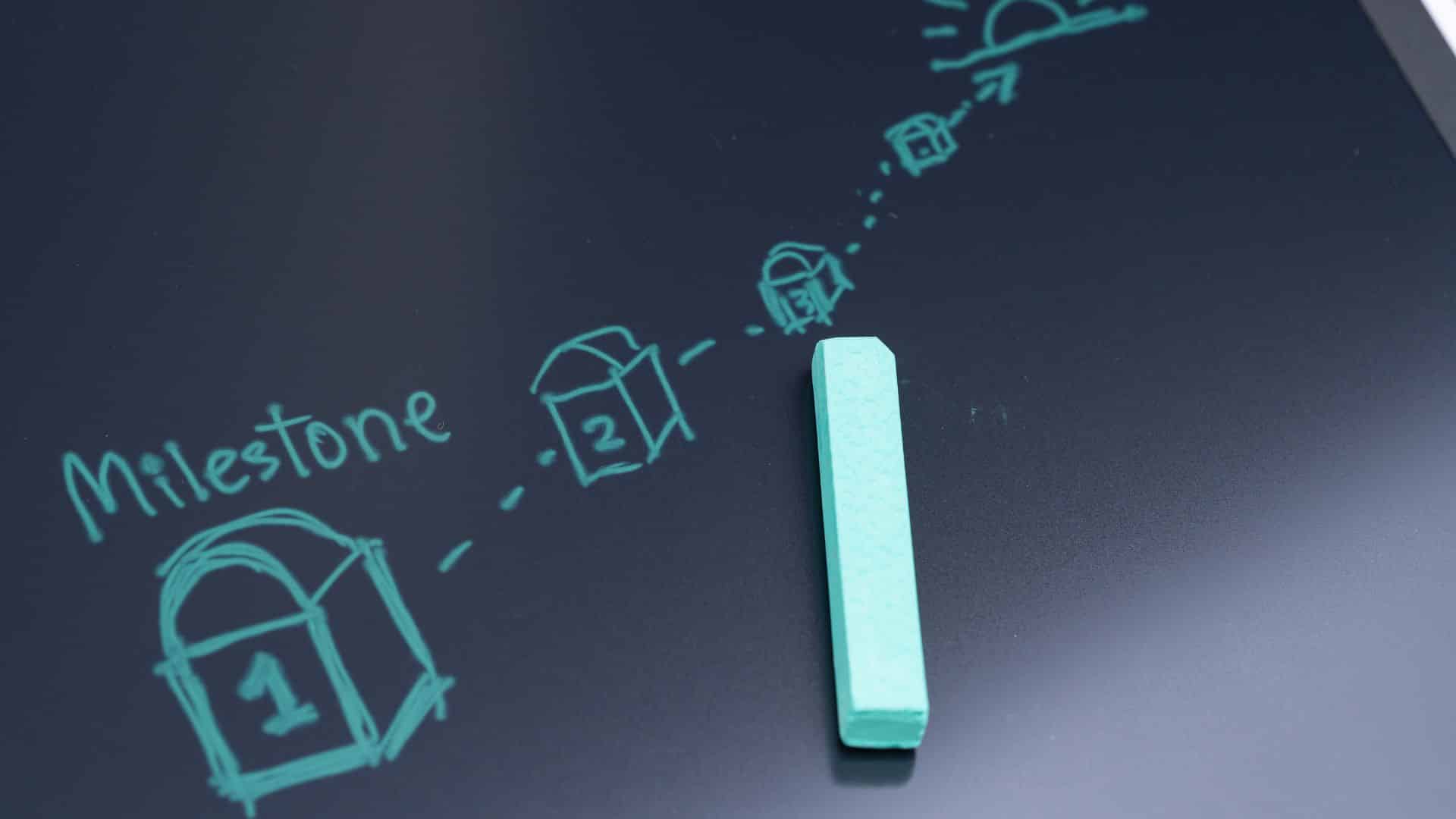To make it easier to track the quality of project management and ensure adherence to the established plan, companies incorporate project milestones, also known as key checkpoints, into the project timeline.
Every project is a unique journey encompassing various stages, including project planning, role sharing, budgeting, and task completion. However, due to the complexity of the project goals, there is no guarantee that the project will unfold precisely as planned.
And this is where the determination of milestones comes into play, which will undoubtedly assist you.
In this article, you will learn why project milestones are an important component of almost every project management process, what they represent, and what the advantages of this method are.
What is a Project Milestone?
A project milestone is a point or event that represents the completion of a specific phase of the project.
Besides team members, project managers benefit the most from using key checkpoints during the project realization phase. They have an insight into the result of each milestone achieved, which is crucial for the team’s efficiency in terms of time, quality, quantity, and communication.
On the other hand, the client will have a clear overview of the project’s progress, which allows them to provide suggestions if deemed necessary.
Why Are Project Milestones Important?
Let’s imagine a group of mountaineers climbing the mountain, with point A being their starting point and point B being the summit. Now imagine that they have no idea what to expect on the journey, going forward with no idea whether they’re on track or what comes next.
Doubt and uncertainty will inevitably start to creep in, leaving them wondering if they are on the right track.
This example makes it easier to realize why the project milestone method is so effective.
Easier project tracking. By dividing the total project completion time into shorter intervals and doing the same for individual tasks, you can easily track whether the project is progressing at an appropriate pace and whether the quality of work is satisfactory. Depending on that, you will know whether you need to course-correct before the next milestone.
More efficient collaboration. As we’ve mentioned, tracking the project’s progress allows the project manager and team to see if they’re on track with tasks while also giving the client insight into what has been done so far and the opportunity to participate in communication with the team and contribute to the project’s effectiveness with suggestions.
Motivation for your team. Now let’s get back to the example with the mountain climbers. When they know in advance that they have four milestones before planting the flag at the top, it will be easier for everyone to see that they are leaving each point behind. They will have time to enjoy the “small victories” and be even more motivated for the next phase.
Project Milestones vs. Project Goals
The main difference between milestones and goals lies in the fact that when we refer to project goals, we mean the ultimate objective we want to achieve through a specific project.
When initiating a project, we immediately set a goal, which defines what we aim to accomplish with that project. We then delve into the details of how to achieve that goal, the means we will employ, and so on. The realization of the project goal is essentially the crown jewel of the project.
On the other hand, project milestones are specific key points on the path to project realization. They represent significant time-bound markers, such as events or achievements, via which we can track the progress and success of our project, identify the needs for any adjustments, and so forth.
Project Milestones vs. Project Tasks
To differentiate between tasks and milestones, it is important to note that project tasks refer to the activities performed that collectively contribute to achieving the project goal. While project tasks are certainly important, they do not represent crucial moments in project realization and can be distinguished from project milestones in that regard.
Another characteristic that sets tasks apart from milestones is that tasks are ongoing with a defined duration, unlike milestones, which are specific points in time or mark the successful end of a certain phase of project development.
To further distinguish milestones, we can look at them as significant events, such as successfully meeting deadlines, moments that positively impact all stakeholders, the finalization of important agreements, and various other moments that shape the project’s progress.
Project Milestones vs. Project Deliverables
Project deliverables encompass the outputs of a project, such as the products or services produced and the overall amount of work completed.
They serve as significant markers that signify the completion of specific processes. These deliverables are typically documented in comprehensive reports that detail the achievements and arrangements made throughout the project.
On the other hand, milestones are distinct accomplishments that represent key moments within the project’s timeline. They serve as pivotal points that denote the completion of specific phases, each with a predefined time frame.
Milestones play a crucial role in tracking the project’s progress, ensuring that activities are executed as planned, and enabling us to stay on the right track with regard to project realization.
How to Identify a Project Milestone
Identifying project milestones is crucial for effective project management. Here are some tips and guidelines for determining what will be a milestone:
- Create a list of steps to complete the project. You’ll be able to focus on the most important points that require special attention.
- Look at the project plan and identify the major deliverables. These deliverables can be used to determine project milestones.
- Consult with team members to identify events that affect the project timeline.
- Set up measurable objectives that can be achieved at each stage of the project. These objectives should be measurable and relevant within a defined time range.
- Listen to what stakeholders and clients think about your project phase division plan and what suggestions they have.
- It’s important to review and adjust project milestones if necessary, as this will ensure that each phase is in line with any new requirements or changes, as well as the team’s needs to perform tasks more efficiently.
By following these tips, you can simply create project milestones that will help you track progress, schedules, and overall success.
Milestone Planning
Milestone planning is a crucial aspect of project management. It involves breaking down the project into smaller, more manageable phases, which helps in tracking progress, managing resources, and staying on schedule.
Here are the steps to follow when creating a milestone plan:
- Define project goals and objectives. This is the starting point for all project planning. Define what the project aims to achieve, what success looks like, and the deliverables required to meet the objectives.
- Identify project milestones. Precisely define each phase that should represent a significant achievement and demonstrate that the project is on track as planned.
- Set timelines and deadlines. Assign a specific deadline to each milestone and ensure it is achievable within the given time frame.
- Create a Gantt chart. Creating a Gantt chart is a popular tool used in milestone planning. It provides a clear overview of the project timeline, tasks, and their dependencies. By using this tool, project managers can more easily identify potential roadblocks and adjust the project plan accordingly.
Project Milestone Examples
Here are some project milestone examples that you can apply to effectively reach your goal:
- Project kickoff meeting: The first meeting that marks the start of the project and sets the direction for the team. It is usually attended by the project manager, stakeholders, and team members.
- Completion of the project plan: The project plan outlines the scope, objectives, timelines, and resources required for the project. It is a critical milestone as it provides a roadmap for the team to follow.
- Assembling the project team: Gathering a project team and defining their roles is another key requirement for an efficient project flow. Each team member should know their role within the team, the tasks assigned to them, and the deadlines within which they must act.
- Completion of project design: A milestone that marks the completion of the project design phase, which includes creating a blueprint or plan of how the final product or service will look.
- Prototype development: A milestone that marks the creation of a working prototype of the product or service. This milestone is critical as it helps identify any issues or potential problems early on in the development process.
- Product or service testing: User acceptance testing is a milestone that marks the completion of testing a product or service with end users to ensure it meets their needs and expectations.
- Launch or go-live date: The final milestone that marks the launch or implementation of the project deliverables and marks the end of the project lifecycle
Why Should You Use Project Milestones
Project milestones crystallize the path toward project realization. They assist in identifying critical steps upon which the project’s success hinges and integrating them into the project plan.
By transparently communicating these milestones, all project stakeholders can align their efforts towards these “mini-goals,” which, upon completion, propel the project toward its ultimate objective.
Implementing project milestones enables effective project tracking, monitoring the completion of activities within specified timeframes, and promptly detecting and addressing any emerging issues.
This proactive approach ensures efficient problem resolution, helping to keep the project on track and achieve desired outcomes in a timely manner.
Conclusion
Make your job easier and more efficient by utilizing project milestones as your compass, which ensures you’re on the right track. A good plan is half the battle, as without it, it’s easy to veer off course.
With milestones, you are guaranteed to always know which phase of the project you’re in, how fast you’re progressing, and whether you’re meeting the set deadlines.
Therefore, concretize your goal by identifying key milestones and events. Once defined, diligently track the entire workflow until you successfully achieve your objective. Best of luck!






